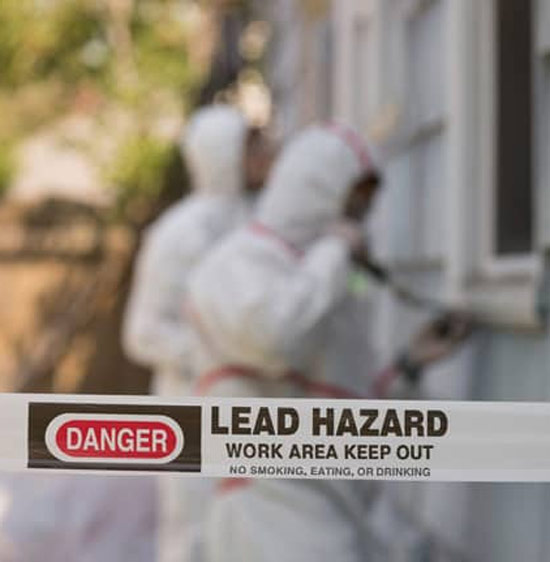Comprehensive Guide on Effective Lead Offense Removal Strategies
In the world of environmental safety and security, addressing lead violations demands a thorough and structured strategy. This comprehensive overview starts by highlighting the vital first actions of determining lead threats with advanced evaluation and screening methods. The guide elaborates on the value of adhering to rigid security procedures during the removal procedure, including the usage of appropriate PPE and isolating influenced areas.
Identifying Lead Threats
Identifying lead dangers is an essential primary step in mitigating the dangers related to lead exposure. Lead, a hazardous metal, can be present in different ecological tools, including paint, soil, water, and dust. It presents extreme health dangers, particularly to youngsters and expectant women, causing neurological damage and developmental delays. Consequently, accurate identification of prospective lead resources is important for efficient removal.
The preliminary phase in recognizing lead hazards includes comprehending common lead resources within the built atmosphere. Frameworks constructed before 1978 are particularly at risk as a result of the common use lead-based paint throughout that duration. Furthermore, soil contamination can occur from wearing away outside paint, industrial emissions, or historic usage of leaded gas.
An additional considerable source is lead piping and pipes fixtures, which can leach introduce alcohol consumption water. Durable goods such as playthings, porcelains, and imported products might additionally include hazardous lead levels. Especially, work-related atmospheres and leisure activities entailing lead can track pollutants into homes.
Evaluation and Screening
When dealing with lead dangers, effective assessment and testing are vital. This essential step makes certain the recognition and quantification of lead existence, therefore guiding subsequent removal initiatives. First evaluation usually includes an aesthetic evaluation to determine potential lead resources, such as wearing away paint or contaminated dust. This is enhanced by even more extensive testing methodologies to establish the extent of contamination.

Dust wipe tasting is an additional essential strategy, particularly in domestic setups. By gathering examples from floors, windowsills, and other surface areas, this method gives insights right into possible direct exposure risks. Moreover, dirt testing around structure borders is important to identify lead contamination that might present risks, particularly to youngsters.
Safe Elimination Procedures
Upon finishing detailed evaluation and screening, applying secure removal treatments is the next crucial stage in dealing with lead risks. This procedure makes certain that lead-contaminated products are efficiently and safely eliminated, minimizing threat to both employees and citizens. The initial step entails separating the afflicted area making use of plastic bed linen and correct sealing methods to stop the spread of lead dirt.
Workers must don ideal personal safety devices (PPE), consisting of respirators, gloves, and non reusable coveralls, to alleviate exposure. Utilizing specialized devices and wet approaches, such as wet fining sand or utilizing HEPA-filtered vacuum cleaners, lowers the dispersion of lead bits. It is critical to avoid dry sanding or unpleasant blowing up, as these methods can create dangerous lead dust.
Waste disposal is another crucial part; all infected materials must be firmly bagged and identified according to EPA and neighborhood policies. Furthermore, detailed cleaning of the job area with click for source HEPA vacuum cleaners and wet wiping makes sure the removal of recurring lead particles.
Post-Removal Verification

Confirmation of effective lead elimination, recognized as post-removal confirmation, is important to make certain the safety and habitability of the remediated location. This inspection ensures that all known sources of lead have been resolved and that no noticeable signs of contamination remain.
Adhering to the aesthetic inspection, environmental sampling is conducted. This entails gathering dust, dirt, and in some cases water samples from the remediated area. Approved research laboratories evaluate these examples to measure lead degrees, ensuring they fall listed below the security thresholds established by regulative bodies such as the Epa (EPA)
In addition, air top quality screening may be carried out to find airborne lead fragments, especially in cases where comprehensive lead-based paint elimination or remodelling has actually occurred. The outcomes of these examinations provide quantitative data validating that the lead levels are within allowable restrictions.
Inevitably, post-removal verification acts as an important checkpoint, verifying the performance of the lead abatement efforts and securing the health and wellness of owners and site visitors.
Preventative Steps and Upkeep

A key preventive measure includes the usage of lead-safe certified professionals for any type of restoration, repair service, or painting activities. These professionals are learnt methods that decrease lead dirt and particles. Additionally, maintaining colored surface areas to avoid cracking or peeling is essential, as degrading paint can launch lead bits into the atmosphere.
Educational campaigns targeting homeowner and tenants pertaining to the risks of lead and the importance of reporting any prospective hazards can even more enhance precautionary initiatives. Routine cleansing making use of HEPA vacuums and damp mopping strategies can dramatically decrease lead dust buildup.
Conclusion
In recap, efficient lead offense removal requires a meticulous method encompassing thorough analysis, precise screening, and rigorous removal procedures. Ongoing assessments and maintenance are necessary to minimize future lead hazards, thereby safeguarding public health and making sure continual compliance with regulative demands.
Comments on “Reputable DOH & HPD Lead Violation Removal in NYC-- Protect Your Home”